Leonardo da Vinci on When to Abandon a Creative Project
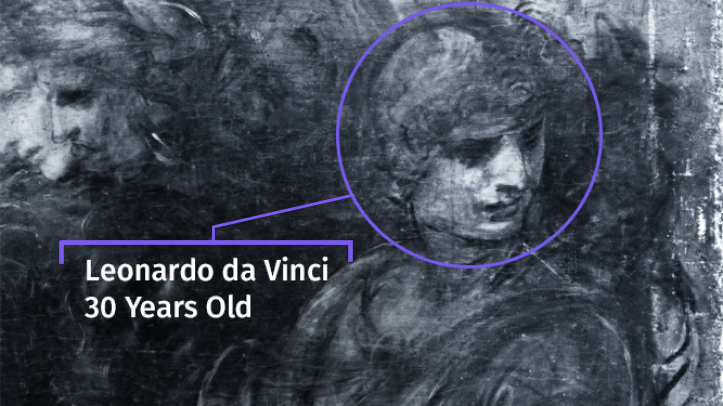
“When I’m finished, I always wonder what would have happened had I made different decisions along the way.”
– Brent R. Laycock
That painting of a 30-year-old Leonardo da Vinci is a self-portrait.
And if you’re wondering why it doesn’t look as perfect as the Mona Lisa…
That’s because it’s unfinished.
Leonardo has lots of unfinished works.
When I visited Florence a few years ago to see this painting, The Adoration of Magi, the tour guide explained to us the reason Da Vinci left behind so many incomplete paintings.
She told us he was, “A CHRONIC PROCRASTINATOR”.
As soon as she spoke those words I knew she couldn’t have been an artist herself.
Artists by nature don’t look for simplistic truths. Artists look for nuanced explanations. They look for the gray zones.
And she missed the gray zone in Leonardo’s supposed procrastination.
A procrastinator is someone who can’t start a creative project.
Leonardo da Vinci was someone who couldn’t stop starting creative projects.
He was not a chronic procrastinator. He was a creative polygamist.
We’ll get back this painting in a moment. First, let’s enter the gray zone.
The Difference Between Starting And Finishing
People love to talk and think and dream of starting. People love to fantasize over the idea of starting so much, so badly, entire books have been written on the subject of starting alone.
Entire 400-page books have been written telling people HOW they should start starting, WHY they should start starting and WHEN they should start starting.
I know, because I’ve read them all. I used to be one of those people. Heck, I’ve even written a short post on starting. But it’s short for a reason…
The whole field of procrastination — every book, every research paper — can be summed up in what took Wordsworth three words:
“To begin, begin.”
– William Wordsworth
Procrastination isn’t the only self-help topic that gets an inordinate amount of air-time, but, thankfully, Wordsworth isn’t the only author who values our time.
Take the classic book title:
“Feel The Fear And Do It Anyway”
– Susan Jeffers
Or this one that even rivals Wordsworth’s:
“Do The Work.”
– Steven Pressfield
It’s nice to own books that teach you life’s greatest lessons without ever having to open them.
Conversely, some topics — important topics — don’t get any fluff-filled books or succinct sound bites to sum them up.
I’m talking, in this case, about the concept of finishing work — the decision to stop tampering and adjusting and just let what is, be.
We’ve seen three great quotes that explain how to start a project, but when I searched for such a slogan on finishing, this is the best I could find:
“A painting is finished when to have done less would be considered a sin and more a crime.”
– Ted Godwin
A valid pearl of wisdom no doubt, but is it helpful?
Imagine… after spending a year of your life writing a novel, or five years chiseling away at a block of marble, sensing the end is near, and asking yourself the question,” What should I not include that would be a sin or add that may be a crime?“.
What Ted Godwin is telling us is to, “Finish when it feels right”.
But Ted, how do you know when it feels right?
Experts are not usually very good at explaining how they do the things they’re experts at.
Chess Grandmasters, for example, when trying to teach others how to play, often repeat their old teacher’s lessons, rather than explain what’s going on in their head.
Being good at something doesn’t automatically mean you’ll be good at teaching it and being a good teacher doesn’t automatically mean you’ll be a good practitioner.
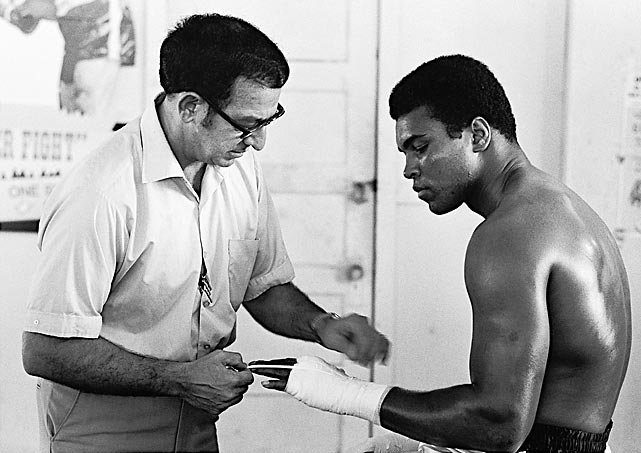
Rembrandt walked in two worlds. He was both a world-class artist and a recognized teacher. Here’s what he had to say about the topic of finishing:
“A painting is finished when the artist says it is finished.”
– Rembrandt
At a first glance, this seems very similar to Ted Godwin’s quote, but it’s not.
What Rembrandt is implying here is that you cannot call yourself an artist (you have no right to create art) if you cannot discern when your own work is finished.
He is saying that to ask the question, “How does one finish a piece of art?” is inherently unartistic.
Is Rembrandt right? Is the question of when to finish a piece of art silly?
Is it like asking, “How do you know when you’re in love?”. Should you just know?
Is finishing that different from starting even? Is it the case that:
“All large tasks are completed in a series of starts.” – Neil Fiore
Here, Rembrandt and Neil Fiore seem to fall on either end of the creative spectrum. Rembrandt is preaching a romantic vision of art, Neil Fiore a mechanical task-oriented one.
If you’re like Rembrandt, then perhaps the question of when to finish a piece of art is silly.
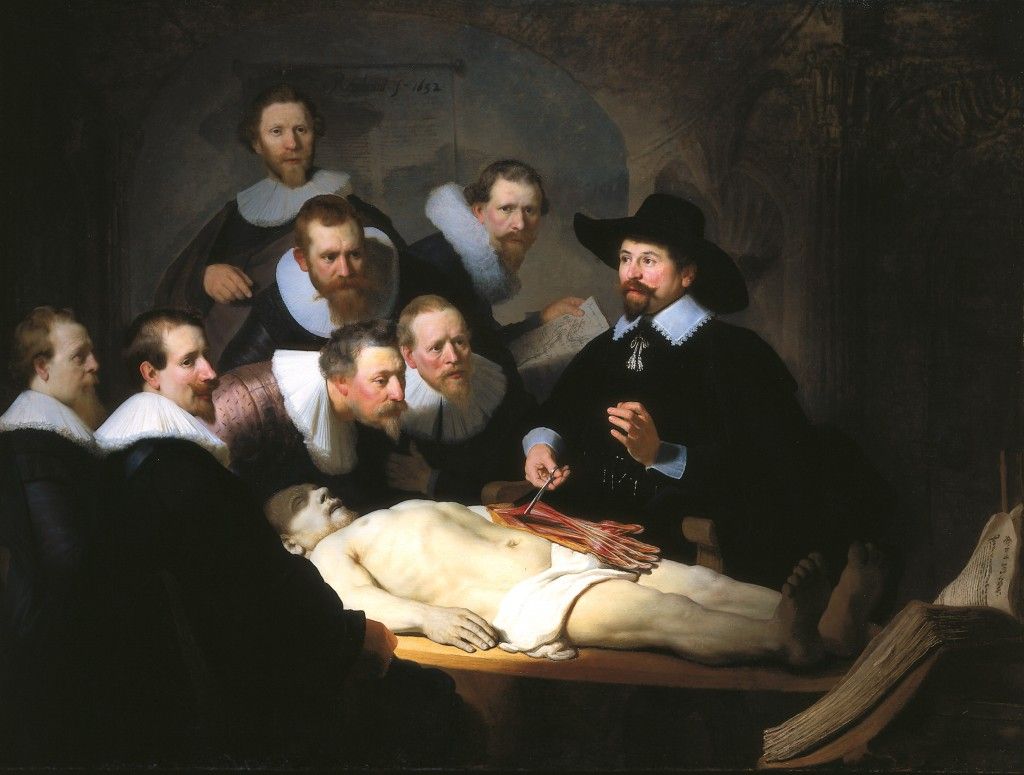
If you’re not like Rembrandt then perhaps you feel the romanticized version of art is similar to the romanticized version of love, in that, neither exists.
The act of creation, like love, usually involves a lot more work, effort, and boredom than the movies make out.
“True love begins where movies end.”
– Tal Ben-Shahar
Leonardo da Vinci is one of the greatest artists of all time, yet he left many works unfinished. Had he not finished those he did, we might never have known his name.
Surely the act of finishing a creative project deserves more attention than it gets?
“A common malady among artists is we sometimes don’t know when to quit. Consequently, we can ruin a good painting by overworking it or by leaving it too soon. There’s a fine line there somewhere, and it’s hard to know when you’ve crossed it.”
– Lesley White
Finishing is temporal. Like comedy, timing is paramount.
We all know when to start (now), but for finishing, as Lesley White says, we can easily overwork, or underwork. We can go too slow and lose momentum, or too quickly and make mistakes.
Maybe the rules are different for mechanical tasks, Rembrandt, and Neil Fiore, but or the rest of us – Leonardo da Vinci included: starting is not the same as finishing.
Finding The Fine Finish Line
That tour guide in Florence isn’t the only one who thinks Leonardo was a chronic procrastinator.
I heard it the same week in the Institute and Museum of Technology and Science, in an audio playing over the exhibitions.
Even his Wikipedia page makes a mention of it.
The first paragraph shows us the Leonardo we are familiar with:
“Leonardo di ser Piero da Vinci; April 15, 1452 – May 2, 1519, Old Style) was an Italian Renaissance polymath: painter, sculptor, architect, musician, mathematician, engineer, inventor, anatomist, geologist, cartographer, botanist, and writer. His genius, perhaps more than that of any other figure, epitomized the Renaissance humanist ideal.”
But in the following paragraph:
“Perhaps fifteen of his paintings survive, the small number because of his constant, and frequently disastrous, experimentation with new techniques and his chronic procrastination.”
As I explained in my article on ‘Aha Moments’, the incubation (giving ideas time to breathe) is a precursor of creative insight. One of Leonardo’s favorite ways of incubating his ideas was to sit in a dark room and let images fill his mind’s eye.
“Men of lofty genius, when they are doing the least work, are most active.” – Leonardo da Vinci
Because Leonardo was a slow worker, statistically, his failures or unfinished works were more personally devastating than to those artists who are more prolific.
In a single decade, Van Gogh produced 2,100 works. 860 of those were oil paintings. Leonardo spent 5-7 years painting the Mona Lisa alone.
A few times in his life, Leonardo was the victim of artistic disasters. A war started just as Da Vinci was about to begin his giant bronze Sforza horse (a project that took years in planning), meaning all the bronze had to be given to the military.
His painting of the Battle of Anghiari was ruined by a devastating flood.
Not only did being a slow worker make his artistic mishaps more statistically significant, but also the chances of a mishap occurring was statistically more likely.
With the Adoration of Magi, however, no one seems to know why it remained unfinished.
The Adoration of Magi, where Da Vinci’s self-portrait was from, took him three years.
Three years of his life, he spent on an underpainting:
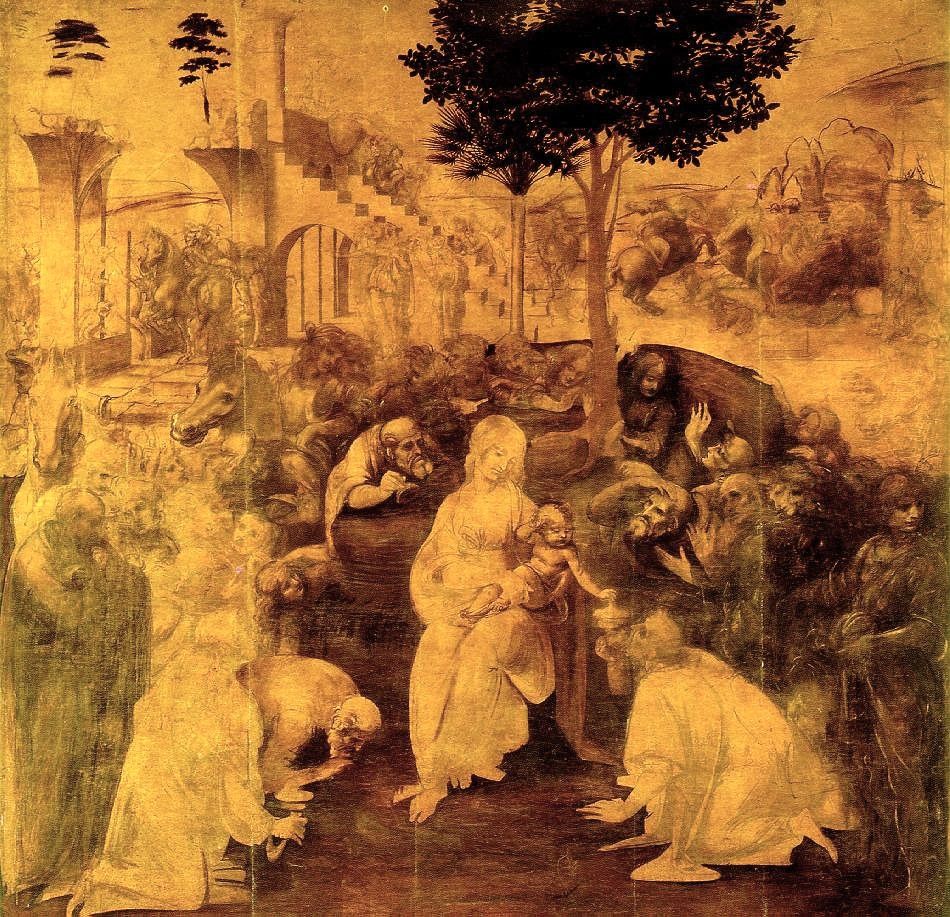
Halfway through my visit to Florence, I found myself trudging through the endless halls of the Uffizi Gallery. My legs were burning from the miles of walking, and my eyes were no longer able to make distinctions between the tens of thousands of artworks I had seen that day.
I saw Botticelli, Michelangelo, Rembrandt, and Caravaggio – all the main attractions. I was ready to call it a day and go home.
On my way to the exit, I passed a large room that had a completely different atmosphere from all of the others. The hundreds of people inside were quiet, the hundreds of paintings inside ignored… bar one.
Everyone, myself included, was utterly transfixed by a large painting in the center of the room. The experience of looking at that painting felt almost religious. There was something different about it.
I moved closer to look at the plaque. The work was by Leonardo da Vinci. The painting was The Adoration of Magi.
It’s remained my favorite painting to this day.
How could an unfinished work command so much prestige and attention and why didn’t Leonardo finish it?
Serge Bramly plays with this question in his Da Vinci biography:
“The incompletion of this picture has always perplexed historians. Leonardo had put a great deal of work into the Adoration, which some consider, even as it stands, to be one of the most extraordinary pictures of the century.”
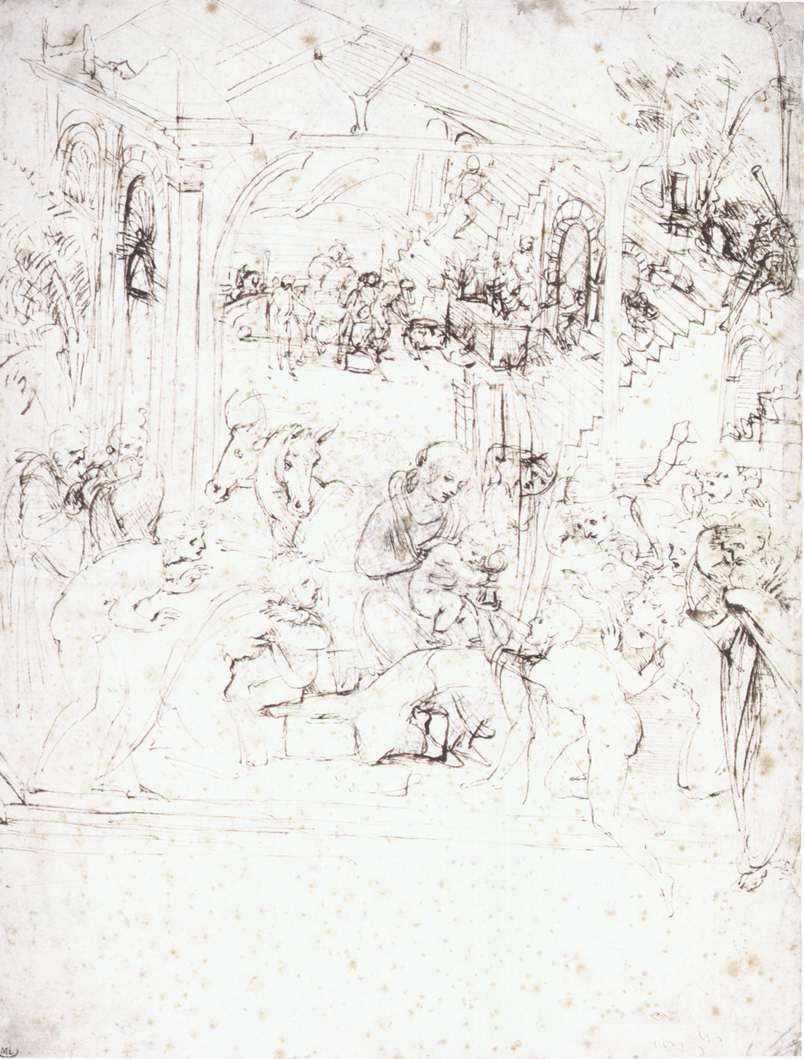
“Truly a great masterpiece and perhaps the quattrocento produced nothing greater.”
– Bernard Berenson, on The Adoration
Bramly goes on:
“Why did Leonardo never finish the painting? Several explanations have been suggested. Vasari provides the most simple: Leonardo was ‘capricious and unstable,’ he said, and did not finish the Adoration because he was incapable of finishing anything. As a kind of justification, he adds: ‘His intelligence of art made him take on many projects but never finish any of them, since it seemed to him that the hand would never achieve the required perfection.’ According to Vasari, Leonardo conceived of problems that were ‘so subtle, so astonishing,’ that he could not resolve them despite his skill.”
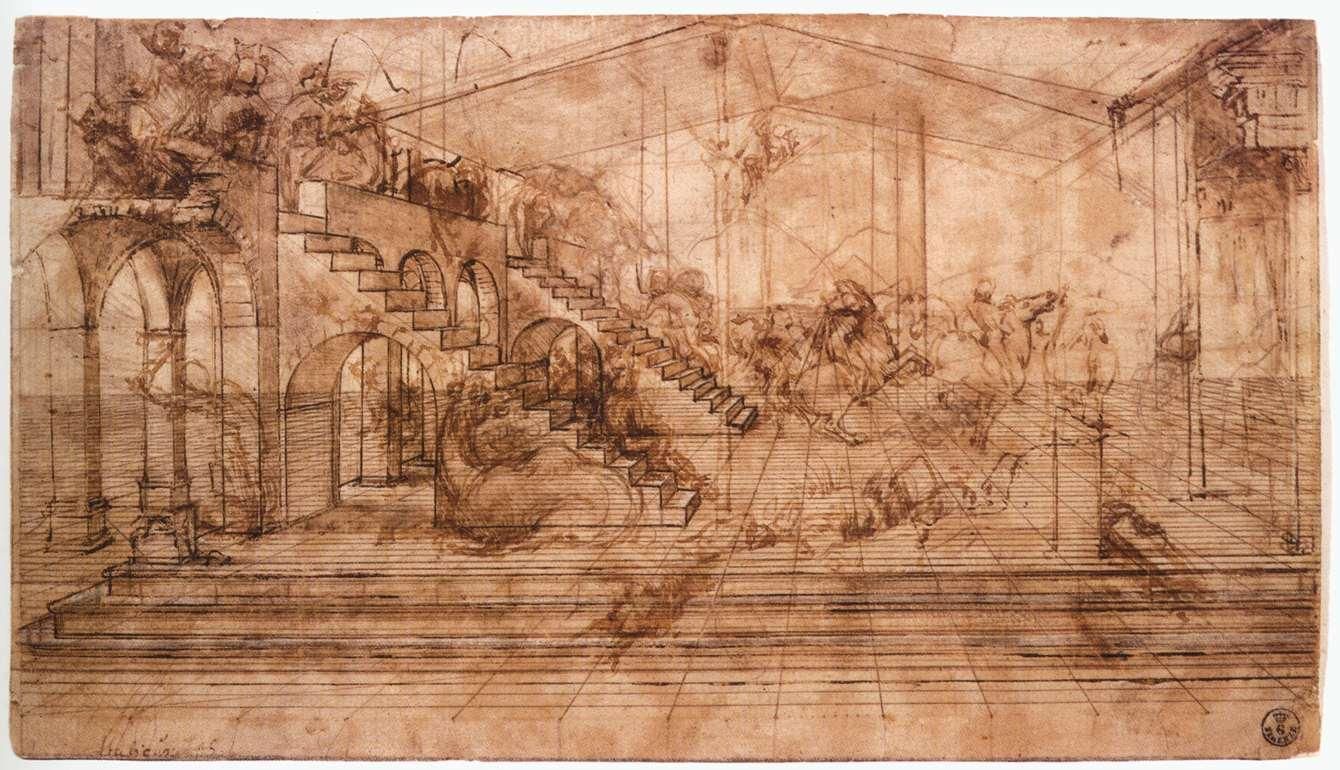
Other critics, as Bramly explains, believe that the Adoration is finished in a Rembrandt kind of way:
“‘Finish is only of value when it is a pure medium of expression,’ according to Kenneth Clark, who thought that the ‘finished’ quality called for by the Florentine ideal would no doubt have shattered the magical charm of the picture. For other critics, the Adoration in its present state) sometimes anachronistically described as Rembrandtesque) is perfect and complete. ‘At this stage, ‘ wrote Sprengler, ‘the supreme achievement and the clarity of intention have been reached.’ Such writers refer to the non-finite effects of Donatello and quote Vasari when he says in his Life of Luca Della Robbia that, ‘rapidly made sketches in the first flush of inspiration express the idea marvellously in a few lines; whereas excessive labor and too great meticulousness deprive the works of all the force and character, and the artist does not realise when to stop.’ Others again believe that Leonardo left the Adoration half complete because as he developed its composition, his art was itself progressing and evolving, so that after seven or eight months spent on this work he was no longer happy with it and was eager to move on to another. We shall never know the truth.”
At one point in history, it was very common to talk about a person’s soul. People would try and discover the secrets of the soul, how the soul worked, what the soul was made up of, etc.
If you believed in souls, then these discussions could become heated, deep, almost scientific in nature. But if you didn’t believe in souls these very same discussions would seem pointless and delusional.
What would Leonardo da Vinci think about the theories of why the Adoration remains incomplete?
Is it possible that Leonardo would see these discussions like an atheist observing a lecture on the soul? Did he share the same view as Picasso:
“To finish a work?… What nonsense! To finish it means to be through with it, to kill it, to rid it of its soul, to give it its final blow the coup de grace for the painter as well as for the picture.”
– Pablo Picasso
Leonardo was infamous for his experimentation techniques. Some of them, like is sfumato technique, pushed the field of art to new heights. Others, like his Last Supper painting, didn’t work out so well.
“Experimentalists never know when their work is finished.”
– Daniel Pink
Vasari was right when he said Leonardo didn’t finish because “It seemed to him that the hand would never achieve the required perfection”.
Leonardo didn’t finish the Adoration because he didn’t believe anything could be finished.
Leonardo didn’t compare the act of finishing to the romantic act of falling in love.
He saw finishing as quite the opposite: a breakup.
“Art is never finished, only abandoned”
– Leonardo Da Vinci
Creating a piece of art is like entering a marriage you don’t want to last forever.
No one wants to spend their entire life on one piece of art, no matter how much they love it.
Even George R. R. Martin has to break up with individual books and characters in his epic Song of Ice and Fire.
To be better at finishing our work, it will help to stop thinking of finishing as the goal.
Finishing a creative project is like finishing a relationship, once it’s begun it can never be terminated — it can never be truly ‘finished’.
The past can never be distinguished, but the future can take its place.
How To Break Up With Your Work
“Finishing books — and leaving the world you’ve created – is always a kind of emotionally wrenching experience. I usually cry.”
– Lauren Oliver
Continuing with our analogy of love and romance, below I’ll describe the four ways and contexts we can break up with our creative work.
Some of them won’t be for you, but they’re all worth experimenting with.
1. The Fling (Deadline)
“Our films are never truly finished. We just get to stop at our deadline.”
– Brad Bird
A deadline can be externally or internally imposed. Filmmakers and artists in the public domain often have tight schedules they must stick to.
Their version of perfection is doing the best they can in the time they have.
Stephen King likes to finish his first draft as quickly as possible. This way he can out-write his self-doubt.
“Try to finish your painting while you are still excited about it. Spend too much time, you lose interest, and the picture begins to fall apart.”
– Van Waldron
Set yourself a deadline and stick to it, no matter what.
2. The Love Affair (Moving On)
“The best way to finish a painting is to start a new one.”
– Sylvio Gagnon
Novelty is arousing.
Sometimes I’ll be reading a book, and I’ll get halfway through and get bored. It’s not that the book isn’t good, but that I want to read something else. I’m excited about other topics.
By sticking with a creative project, you are no longer engaged with is artistic suicide. Your work will suffer and so will you.
“Put your energy into ‘finishing’ — and you’re missing your next great painting.”
– J. R. Baldini
This is what Leonardo da Vinci seemed to be experiencing with his Adoration of Magi.
If you feel yourself pulled towards another project, follow your instincts.
3. The Divorce (Despising Your Work)
“I’m finished when I can’t stand it anymore.” – Ron Monsma
Some relationships end messily.
When I was in university, I painted a portrait. It started off well but the more I worked on it, the worse it became. I hated it.
I was ready to break the canvas apart but decided I should try and sell it on eBay before destroying it.
It sold in two days. That was my first art commission. A painting I couldn’t stand the sight of.
“One always has to spoil a picture a little bit in order to finish it.”
– Eugene Delacroix
Don’t be afraid to put work out into the world that you no longer like. Our favorite films might be our most hated after a thousand views.
4. The Temporary Break (Shelving Your Work)
“When something is finished, that means it’s dead, doesn’t it? I believe in everlastingness. I never finish a painting – I just stop working on it for a while.”
– Arshile Gorky
My brother married his high-school sweetheart. Now they have a home and two happy children.
After the high-school romance they did, however, have a temporary break… for ten years.
Leonardo worked on The Mona Lisa this way. He would shelve it for months or years at a time then spontaneously do some work on it.
The film director Woody Allen has directed films 30 years after he wrote the script. James Cameron wrote the Avatar script more than a decade before he shot it.
Sometimes the chemistry is right but the timing is wrong. In these instances, shelve your work. Come back to it later with a fresh pair of eyes.
Finishing This Article
Not being able to finish a creative project doesn’t make you a procrastinator.
This article was the first article I intended to write when I started Comfort Pit, but I became frustrated with it and shelved it.
In the meantime, I wrote 22 other articles. Does that make me a chronic procrastinator?
Don’t worry about cheating on your creative projects, don’t worry about hating them or shelving them.
Be a creative polygamist, Leonardo was.